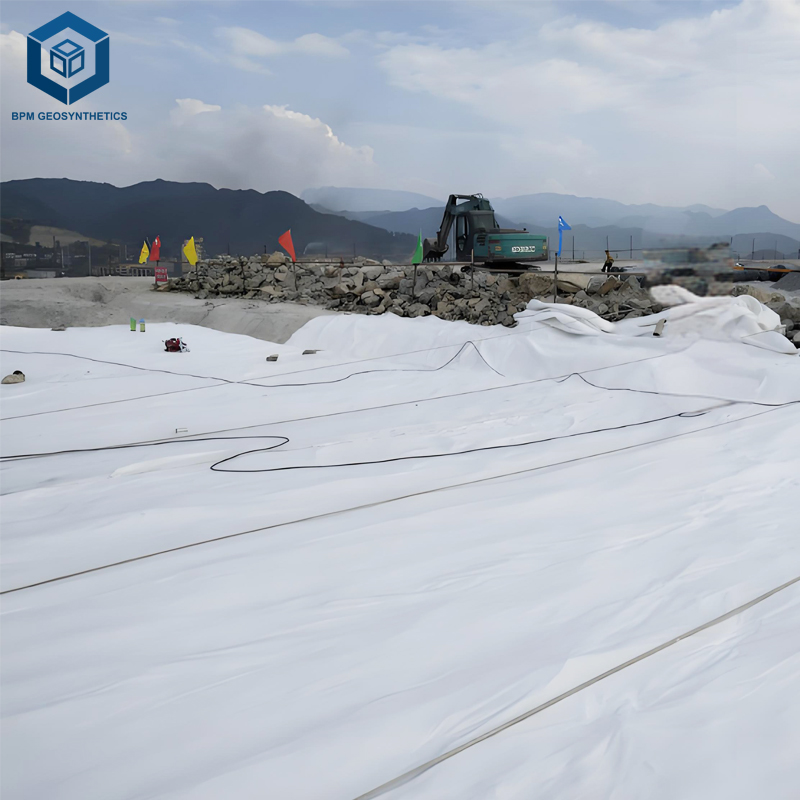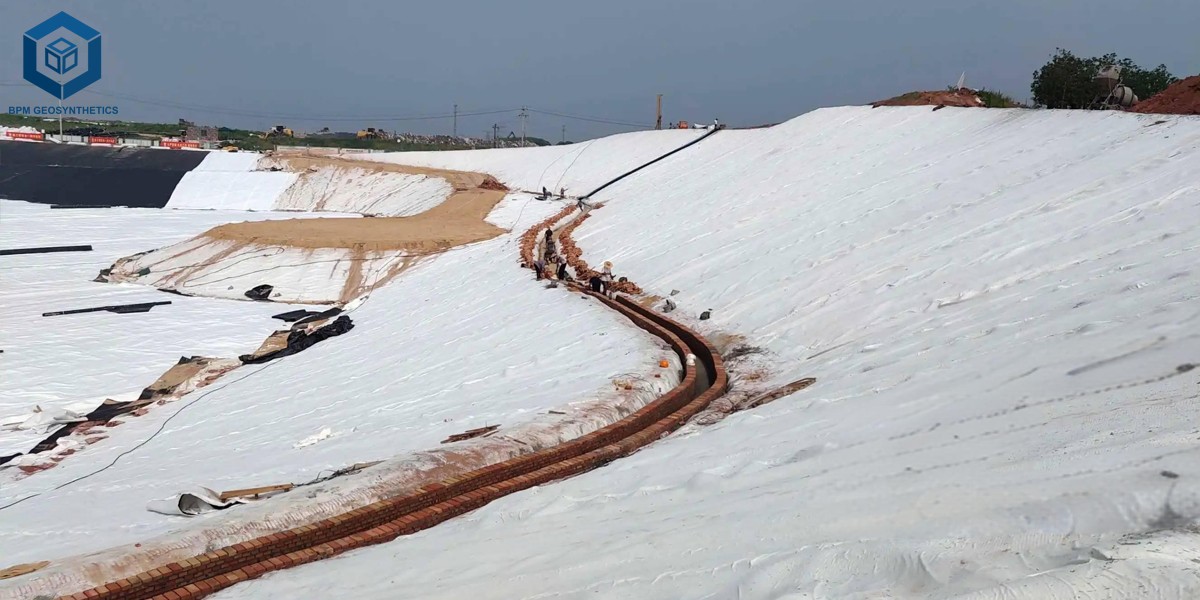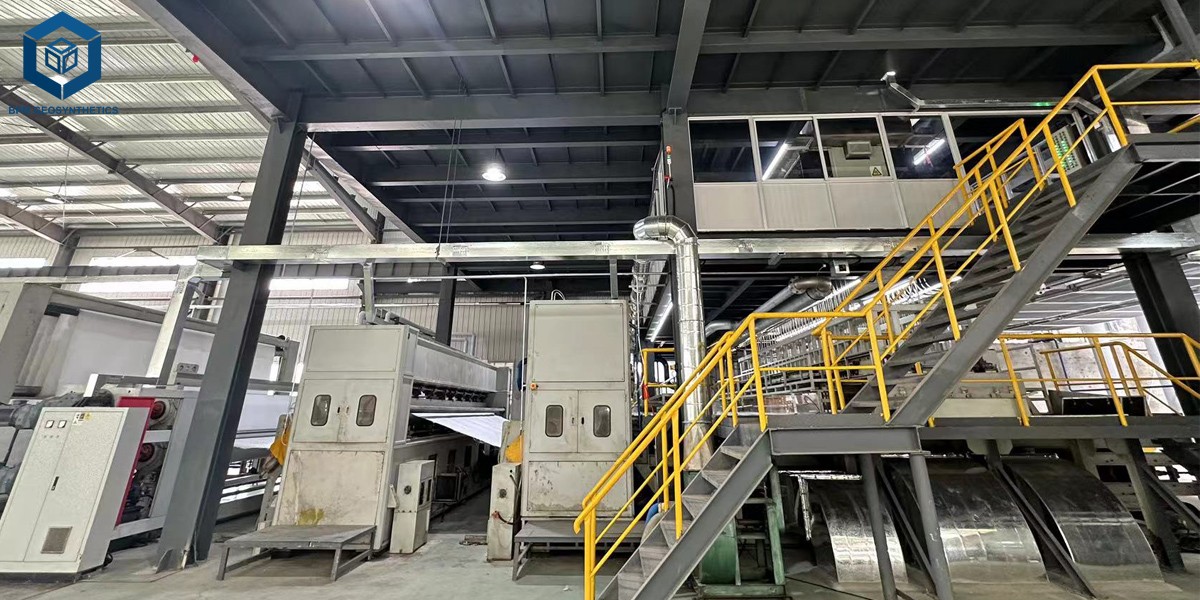Filament Geotextile
Filament geotextile is high-performance woven fabrics made from continuous synthetic fibers, designed specially for a range of civil engineering and environmental applications. These filament geotextiles have remarkable strength, durability, and filtering ability, making them an perfect preference for avenue construction, protecting walls, and erosion manage projects. Its sturdy shape approves for nice soil separation and stability, making sure the lifespan of infrastructure whilst advertising drainage.
-High tensile strength: Filament geotextiles have brilliant load-bearing capacity, making them appropriate for heavy-duty applications.
-Effective filtration: They enable water to bypass via whilst stopping soil erosion, making sure device balance and properly drainage.
-Durability: These filament geotextiles are resistant to ultraviolet radiation, chemicals, and biodegradation, and have long-lasting overall performance in harsh environments.
Filament geotextile is superior geosynthetic substances manufactured from non-stop filaments, designed to supply most suitable strength, durability, and filtration overall performance in a vast vary of civil engineering and environmental projects. At BPM Geosynthetics, we mix modern manufacturing technological know-how with rigorous best manipulate to produce filament geotextile material that meet the best worldwide standards.
1. Filament Geotextile Product Overview
Filament geotextile is composed of high-strength polymer filaments, commonly polypropylene (PP) or polyester (PET), which are extruded and thermally bonded into a durable, nonwoven or woven structure. Unlike staple fiber geotextiles, filament geotextiles provide fantastic tensile strength, wonderful elongation control, and better resistance to puncture, tearing, and environmental degradation. These points make them perfect for functions the place long-term steadiness and mechanical overall performance are critical.
2. Filament Geotextile Technical Specifications
Parameter | Typical Range |
Unit Weight | 150–500 g/m² |
Thickness | 1.0–5.0 mm |
Tensile Strength | 20–60 kN/m |
Elongation at Break | 10–25% |
Permeability | 50–300 l/m²/s |
UV Resistance | ≥ 500 hours |
Chemical Resistance | Resistant to acids, alkalis, and salts |
3. Filament Geotextile Manufacturing Process
Our filament geotextile is produced the use of brand new extrusion and bonding technology, combining superior equipment with unique procedure manage to supply high-quality, dependable products.
3.1 Filament Extrusion
High-quality polymer granules, generally polypropylene (PP) or polyester (PET), are melted and extruded into non-stop filaments beneath cautiously managed temperature and pace conditions. This specific manage ensures uniform filament diameter, constant tensile strength, and minimal defects, which shape the basis for gold standard material performance.
3.2 Bonding Process
The extruded filaments are then converted into a long lasting filter geotextile structure. Depending on the product type, filaments are both thermally bonded—using warmness to fuse fibers together—or routinely entangled thru superior needle-punching technology. This outcomes in a material with excessive tensile strength, extraordinary dimensional stability, and long-term durability, succesful of withstanding heavy masses and harsh environmental conditions.
3.3 Finishing and Quality Control
The bonded geotextile fabric is rolled, trimmed, and inspected via rigorous pleasant checks. Parameters such as thickness, weight, permeability, and tensile energy are measured to make certain every roll meets or exceeds global standards. Automated and guide inspections work collectively to keep consistency throughout manufacturing batches, guaranteeing dependable overall performance for annoying civil engineering applications.
This complete manufacturing method ensures that BPM filament geotextiles supply high-quality strength, durability, and long-term stability, making them appropriate for a vast vary of infrastructure, drainage, and erosion manage projects.
4. Filament Geotextile Key Features and Advantages
4.1 High Tensile Strength
The non-stop filament structure of our non woven geotextile fabric gives notable reinforcement and load-bearing capacity. This makes them best for heavy-duty functions such as avenue and railway stabilization, slope reinforcement, and basis support, the place dependable mechanical overall performance is critical.
4.2 Durable and Long-Lasting
Our filament geotech fabric is engineered to stand up to harsh environmental conditions. They are relatively resistant to UV exposure, chemical attack, and organic degradation, making sure long-term steadiness even in excessive climates. This sturdiness reduces the want for generic replacements and maintenance, presenting value financial savings over the lifestyles of the project.
4.3 Efficient Filtration and Drainage
The special open shape of the geo fabric lets in water to skip via whilst successfully preserving soil and best particles. This ensures perfect drainage, prevents soil erosion, and continues structural integrity in embankments, protecting walls, and landfill applications.
4.4 Lightweight and Easy to Install
Despite their excessive strength, filament non woven geotextile is light-weight and handy to handle. Rolls can be transported efficaciously and mounted quickly, lowering labor requirements, tools costs, and universal mission timelines. This ease of set up is specially treasured for large-scale civil engineering and infrastructure projects.
4.5 Consistent Quality
Our completely computerized manufacturing manner ensures uniform fiber distribution, particular thickness, and regular bodily homes throughout all batches. Every roll non woven landscape fabric undergoes strict first-rate inspections in our manufacturing unit laboratory, making sure that engineers and contractors obtain dependable merchandise that meet global requirements and operate predictably in the field.
These blended elements make BPM filament geotextiles a versatile, reliable, and low-cost answer for a broad range of engineering, environmental, and industrial applications.
5. Filament Geotextile Common Applications
Filament geotextiles are surprisingly versatile materials, extensively utilized in civil engineering, environmental protection, and industrial initiatives due to their strength, durability, and filtration properties. Key purposes include:
5.1 Filament Geotextile for Road and Railway Construction
Filament nonwoven geotextile fabric is used to separate subgrade soil from aggregates, supplying stabilization and uniform load distribution. This prevents rutting, reduces deformation beneath heavy traffic, and extends the carrier lifestyles of roads, highways, and railway tracks. Their excessive tensile power ensures dependable overall performance even beneath dynamic loading conditions.
5.2 Filament Geotextile for Drainage Systems
These geofabric act as high-quality filtration layers, permitting water to pass by whilst stopping soil particles from clogging drains. Geotextile drainage fabric is frequently used in holding wall backfills, sports activities area drainage, and landfill leachate systems, the place environment friendly water administration is quintessential to stop soil erosion and structural damage.
5.3 Filament Geotextile for Slope Protection and Erosion Control
Filament geotextile filter fabric strengthen soil on embankments, riverbanks, and coastal areas. By stabilizing slopes and stopping soil displacement, they assist mitigate erosion precipitated through rainwater, floor runoff, and tidal action. Combined with vegetation or rock armoring, they provide long-term environmental protection.
5.4 Filament Geotextile for Landfill and Waste Containment
Serving as defensive layers over geomembranes, filament geotextile fabric under gravel beautify the sturdiness of landfill liners by means of lowering punctures and stopping direct contact with sharp objects or debris. This ensures safer containment of waste substances and prolongs the useful lifespan of the landfill system.
5.5 Filament Geotextile for Industrial and Agricultural Applications
Filament geotextile landscape fabric furnish reinforcement, filtration, and separation in foundations, irrigation channels, drainage layers, and farmland safety projects. They assist hold soil stability, stop sediment loss, and make sure environment friendly water waft for agricultural or industrial operations.
By combining excessive strength, brilliant permeability, and long-term durability, filament geotextiles provide dependable options throughout more than one engineering and environmental scenarios, making them a desired desire for contractors and venture engineers worldwide.
6. Filament Geotextile – Case Studies
BPM filament geotextiles have been effectively applied in a range of civil engineering, environmental, and industrial initiatives worldwide. These case research spotlight the reliability, durability, and versatility of our merchandise in real-world applications.
6.1 Filament Geotextile for Highway and Road Construction in Southeast Asia
In a foremost toll road project, BPM polyester filament geotextile had been used for subgrade stabilization and separation between soil layers and aggregate. The geotextiles increased load distribution, avoided rutting beneath heavy traffic, and decreased long-term preservation costs. Field inspections proven super tensile energy retention and dimensional balance over a couple of seasons.
6.2 Filament Geotextile for Landfill Drainage Systems in Urban Infrastructure Projects
In a giant municipal landfill, filament polyester filament geotextile have been mounted as a shielding layer above geomembranes. They avoided punctures from waste particles and superior drainage efficiency, making sure the long-term integrity of the liner system. The geotextiles maintained filtration overall performance notwithstanding non-stop publicity to leachate and heavy loads.
6.3 Filament Geotextile for Riverbank and Coastal Erosion Control in Coastal Regions
Along susceptible riverbanks and coastal embankments, BPM filament filament polyester geotextile had been used to strengthen soil and stabilize slopes. Combined with vegetation and rock armoring, they successfully avoided soil erosion and sediment displacement at some stage in heavy rainfall and tidal surges. Post-project monitoring confirmed minimal soil motion and excessive durability.
6.4 Filament Geotextile for Industrial and Agricultural Reinforcement Projects
Filament geotextile material have been utilized in irrigation channels, agricultural fields, and basis reinforcement projects. They facilitated environment friendly water drainage whilst stopping soil loss, making sure secure foundations for tools and long-term agricultural productivity.
These real-world purposes reveal that BPM filament geotextiles supply steady performance, excessive durability, and dependable safety throughout various environments and engineering challenges. By selecting our products, engineers and contractors can make certain task stability, safety, and long-term fee efficiency.
7. Filament Geotextile – Packaging and Logistics
BPM filament geotextiles are designed no longer solely for excessive overall performance in the subject however additionally for environment friendly transportation, storage, and on-site installation. Attention to packaging and logistics ensures that merchandise arrive safely, intact, and prepared for instant use.
7.1 Filament Geotextile Roll Dimensions and Weight
Filament filter geotextile is furnished in rolls with customizable width and size to go well with undertaking requirements. Typical roll widths vary from 1 to 6 meters, with lengths up to 100 meters or more. Roll weights are managed for handy handling, generally between 50 to 400 kg, relying on polypropylene filament geotextile weight and thickness.
7.2 Filament Geotextile Packaging Methods
- Rolls are cautiously packaged to shield the pet filament geotextile at some stage in transport and storage. Packaging picks include:
- Paper cores to hold roll form and forestall deformation.
- Protective plastic movie to defend towards moisture, dust, and UV exposure.
- Wooden pallets for bulk shipments, facilitating protected stacking and forklift handling.
7.3 Filament Geotextile Ease of Transport and Installation
The light-weight and bendy nature of filament geotextile rolls permits for environment friendly loading, unloading, and transport, decreasing logistical costs. On-site, rolls can be unrolled rapidly and reduce to size, simplifying set up even in large-scale infrastructure initiatives or difficult terrain.
7.4 BPM Filament Geotextile Global Supply Capability
With large-scale manufacturing and streamlined logistics, BPM can supply filament geotextiles to initiatives international in a well timed and low cost manner. This ensures that engineers and contractors can preserve tight challenge schedules except delays.
By combining strong packaging, optimized roll dimensions, and transport efficiency, BPM filament geotextiles supply a realistic and handy answer for each procurement and area operations, decreasing dealing with dangers and set up time.
Conclusion
Filament geotextiles from BPM Geosynthetics provide an most effective aggregate of excessive strength, durability, and dependable filtration performance, making them a favored preference for engineers and contractors worldwide. Whether utilized in street construction, drainage systems, or erosion control, BPM’s merchandise supply steady high-quality and long-lasting solutions, backed by way of a manufacturing unit dedicated to excellence and innovation. Choosing The Best Project Material Co., Ltd (BPM Geosynthetics) ensures performance, reliability, and peace of thinking on each project.











